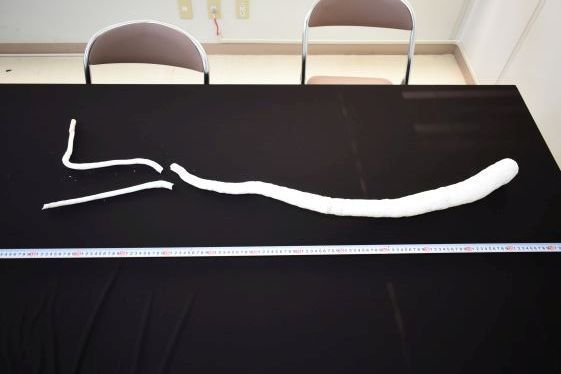First Entotsugai Observed in Japan Discovered in Iriomote Island

The tube (right) and the exhalant and inhalant siphons (left) of the entotsugai collected by Doctor Hiroyuki Ozawa. Combined, the tubes are longer than 1.3 meters (April 7, Okinawa Prefecture Environment Science Center in Kyozuka, Urasoe)
April 8, 2022 Ryukyu Shimpo
By Shugo Asato
The first entotsugai (giant shipworm) to be observed in Japan has been confirmed in Funauki Bay of Iriomote Island in Taketomi, Okinawa. The entotsugai is the longest bivalve in the world and forms a calcareous tube that is distinct from its shell. The tube can be longer than 1.5 meters. The shell and the soft body of the entotsugai are inside of the tube.
The entotsugai was discovered by Doctor Hiroyuki Ozawa of the Okinawa Prefecture Environment Science Center and his team, who were out doing work for the prefecture. Ozawa says, “This discovery is another confirmation of the abundance of the ecosystems around Iriomote Island and Okinawa.”
Entotsugai have been confirmed living in the tropical regions of the Indian and the western Pacific Oceans. The furthest north they had been observed was in the Philippines. However, the discovery in Japan means that the northern limit of their habitat will be redrawn. Additionally, entotsugai are known to live in the waters near mangrove forests, but have now also been observed living in the sandy ocean floor around marine kelp forests.
Ozawa says, “This is an incredibly rare animal that, even within the Iriomote Island area, has only been observed in a very limited part of Funauki Bay. It is my hope that Japan, Okinawa, and Taketomi will quickly take action to protect and conserve the species.”
(English translation by T&CT and Ellen Huntley)
Previous Article:“Obviously reporting,” Naha mayor criticizes solider pointing gun at Shimpo journalist
Next Article:Governor Tamaki declares “7th wave” of the coronavirus as 1,355 new cases are confirmed in Okinawa
[Similar Articles]
- Large coral reefs found in the seas surrounding Iriomote, Ishigaki Islands
- Events to mark the 50th anniversary of Iriomote cat’s discovery
- Collectable stamps of the Iriomote wild cat to help raise funds for its protection
- Taketomi-Tsushima joint declaration on conserving endangered Wildcats
- Taketomi Town to create “Iriomote Wild Cat Day”
 Webcam(Kokusai Street)
Webcam(Kokusai Street)


